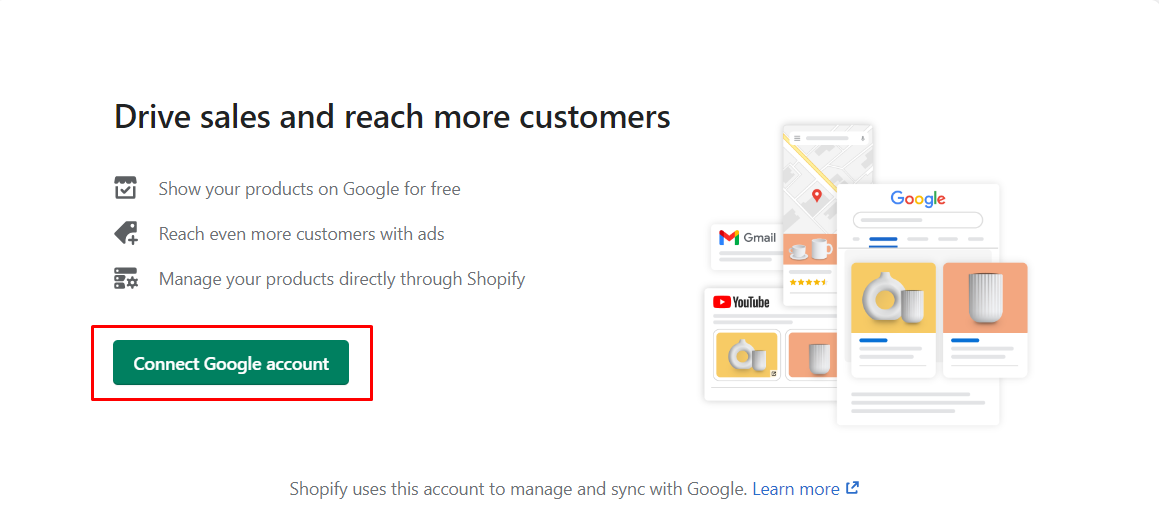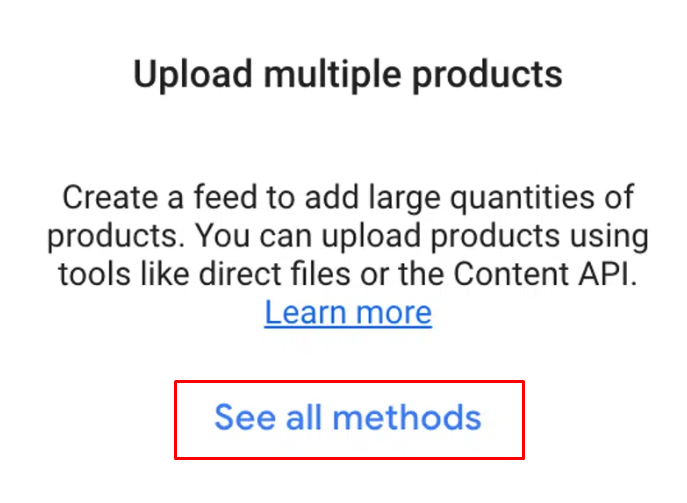How to Set Up Google Merchant Center Feed for Shopify Store

The advantages of Shopify are undeniably appealing to many individuals. Regardless of the size of your business, Shopify provides a platform for building an online store. Some prominent brands such as GymShark or Kylie Cosmetics also utilize the platform for their sites.
However, solely selling on a single market may not be sufficient for business growth. It’s advantageous to expand by adding products to Google Shopping. Focusing on reaching out to the vast number of users on Google could substantially boost the exposure of your products, potentially resulting in increased success for Shopify stores. If you’re a merchant seeking to boost sales, this guide on connecting Shopify to Google Merchant Center is tailored to your needs.
What is Google Merchant Center?
Google Merchant Center, which is provided by Google for free, is a handy tool that allows you to connect your online store with Google’s platform. You achieve this connection by sharing information about your products using what’s called a product feed. This feed essentially sends details about your products, like their names, descriptions, prices, and availability, to Google.
Once Google has this information, it can use it to create what are known as Shopping Ads. These ads display your products and can show up in many different spots on Google, which helps potential customers find and buy what you’re selling more easily.
Benefits of Connecting Shopify to Google Merchant Center?
To broaden your business horizons, merely selling on a single platform may not suffice. Using a multichannel selling approach is a smart tactic that can help you connect with more people and improve the overall experience for customers. Integrating Shopify with Google Merchant Center presents numerous opportunities for business expansion and increased sales.
Here’s a closer look at some of the key benefits:
Reach a broader audience
Linking Shopify to Google Merchant Center grants you access to the vast reach and capabilities of the Google ecosystem. With Google registering over 3.5 billion daily searches, utilizing Google Shopping can greatly boost your visibility. This means your products can show up in searches that are relevant, bringing more visitors to your website.

While this presents a lucrative opportunity, it’s essential to acknowledge the fierce competition within the e-commerce landscape. Despite Google’s potential, not every business can effectively capture this traffic.
Offer diverse purchasing options
By integrating with Google, customers can easily discover your products across various Google services, expanding your reach to new segments. This allows customers to make purchases not only directly from your website but also while browsing the internet.
Catering to different purchasing preferences is crucial for attracting a wider customer base. Selling on both your Shopify store and Google Shopping accommodates diverse consumer behaviors.
However, managing multiple platforms can be overwhelming in terms of inventory and order management. Having a well-thought-out plan in place is vital to streamline operations across multiple channels.
Enhance customer satisfaction
Looking ahead, developing a strategy to leverage Google Ads or other Google services can further enhance your business prospects.
By integrating Shopify with Google, you gain access to advanced analytics tools such as Google Ads and Google Analytics. Analyzing relevant data enables merchants to gain insights into customer behavior and tailor comprehensive services or experiences accordingly. Google Analytics provides valuable information on customer interactions with your online shop, including their origins, preferred products, and browsing duration, facilitating the optimization of your Shopify site’s performance.
Additionally, Google Ads campaigns can significantly boost brand awareness by targeting diverse audience segments, from broad to niche-specific demographics.
Requirements to list products Shopify in Google Merchant Center

Merchants aiming to list their products for free on Google Merchant Center must adhere to specific requirements, including:
- Ensuring the visibility of a refund policy and terms of service on their website.
- Linking products solely to their respective landing pages.
- Adding a valid payment method.
- Displaying contact information on the site.
Once these requirements are met, merchants are prepared to commence uploading Shopify products to Google Merchant Center.
Mageplaza Product Feed for Shopify
Automate and optimize your feed uploads across multi-channels.
Check it out!
How to set up the Shopify product feed in Google Merchant Center
Setting up the Shopify product feed in Google Merchant Center requires a few steps to ensure smooth integration with Google’s sales channels and adherence to their policies. Here’s a guide to get you started:
Step 1: Enable products in Shopify to display in the product feed
Once your Shopify store is live, the first step is to enable your products to be visible in Google Shopping. Ensure that your product descriptions, headlines, and images meet Google’s requirements for optimization.
- Navigate to the “Sales channels and apps” section in your Shopify dashboard and select “Google” from the menu.
- This action will push your products to Google Merchant Center for review.

Step 2: Review product status in Google Merchant Center
After selecting Google as a sales channel, your products will undergo review by Google, resulting in one of three statuses:
- Pending: Google is assessing whether your products adhere to their advertising policies.
- Approved: Products meet Google’s requirements and are ready for promotion.
- Not approved: Issues require resolution before products can be promoted.
Step 3: Connect Shopify with Google Merchant Center
To push your products effectively, you need to establish a connection between Shopify and Google Merchant Center.
- In your Shopify dashboard, navigate to the “Sales channels” section and select “Google.”
- Connect your Google account by following the on-screen instructions.

- Then, connect your Merchant account (if you haven’t got one, please create a new account on the Merchant Center website).

- Ensure that your product adheres to Google’s policies to facilitate seamless integration between the two systems.
By following these steps, you can effectively set up the Shopify product feed in Google Merchant Center, enabling your products to reach a broader audience through Google’s sales channels.
How to set up a Google Merchant Center product feed
Setting up a product feed in Google Merchant Center might seem daunting at first glance, but with some familiarization, it becomes manageable. To get started, ensure a smooth connection between Shopify and Google Merchant Center, and then proceed to fetch your product feeds from Shopify and format them correctly within the Merchant Center. Once this is accomplished, you can initiate paid promotions for your products within Google’s shopping inventory.
Step 1: Create a Product Feed in Merchant Center
After successfully linking Shopify and Google Merchant Center, establish an API connection to transfer products from Shopify to Google.

Navigate to “See all methods,” follow the prompts, and opt for “Content API.” Choose your language and country to finalize the connection.

However, bear in mind that Google requires a full approval process, which typically takes three to five working days. Unfortunately, there’s no expedited option available, so plan accordingly to avoid scheduling issues for your Google shopping promotions.
Step 2: Check Content API Connection
With your products now available in Google Merchant Center, you can monitor their status via a straightforward diagnostic screen.
Active products, denoted by a green indicator, are eligible for sale on Google Shopping. Google enforces stringent criteria, and certain factors may lead to disapproval.

Step 3: Address Google Merchant Center Disapprovals
Google may reject products for various reasons, such as promotional overlays, missing prices, or incomplete descriptions. Fortunately, Google provides a list of these issues, simplifying the troubleshooting process.
Common issues, like “Missing value [shipping],” are typically straightforward to rectify. If issues persist, it may be due to discrepancies with Google’s policies, which are clearly outlined on their disapproval web pages.

Resolving these issues prompts a reevaluation from Google, which may take an additional 3 to 5 working days.
2 methods to add products to Google Merchant Center
There are various ways to link Shopify with Google Merchant Center. Essentially, you can manually input products into Google Merchant Center or utilize the Shopify Google Shopping app for automated product listings. This guide will cover both methods to provide you with the optimal solution.
Method 1: Manually Adding Products to Google Merchant Center
-
Sign in to your Google Merchant Center account.
-
Navigate to the Products section from the menu, leading you to the Add product page.

- Opt for Add products from a file.

-
Select the file from your computer. Accepted file formats include .tsv, .xml, .txt, up to 4 GB in size.
-
Choose Add products from file, and the process is complete.
However, this approach demands significant effort as it doesn’t synchronize changes from your Shopify store. Consequently, any updates will necessitate starting the process anew, posing challenges, especially with a large inventory of products.
Method 2: Utilizing Google Shopping Feed Apps from the Shopify App Store The Shopify app store offers numerous apps designed to assist with managing product feeds. Here are our current top 3 recommendations:
- Google & Youtube by Google LLC
- Simprosys Google Shopping Feed by Simprosys InfoMedia
- Multifeed Google Shopping Feed by WoolyTech
Many Shopify store owners tend to opt for the Google & Youtube app without exploring other options. It’s important to note that with the Google & Youtube app, users may be encouraged to create a Performance Max campaign, which may not always be the most suitable choice.
FAQs
Can I connect my Shopify store with Google Merchant Center?
Yes! Linking your Shopify store with Google Merchant Center enables your products to be displayed on both your website and Google Shopping. This integration allows potential buyers to view your products and compare them with offerings from other vendors that appear in their search results.
How much does it cost to add my products on Google Merchant Center?
Listing on Google Merchant Center is absolutely FREE. Google Merchant Center is a free tool offered by Google, which enables sellers to easily oversee the link between their eCommerce platform and Google’s systems. This facilitates the effortless connection of all your product data.
Is it necessary to sell on Google Merchant Center?
Expanding your business often requires more than just selling in one market. Integrating Shopify with Google Merchant Center can open up numerous opportunities to grow your business and increase sales.
Read more:






![Top 20+ Must-have Shopify Apps for 2025 [Free & Paid] - Mageplaza](https://cdn2.mageplaza.com/media/blog/must-have-shopify-apps/top-must-have-shopify-apps.png)
![[2025 Updates] Top 10+ Upsell Apps for Shopify - Mageplaza](https://cdn2.mageplaza.com/media/blog/best-upsell-shopify-app/cover.png)